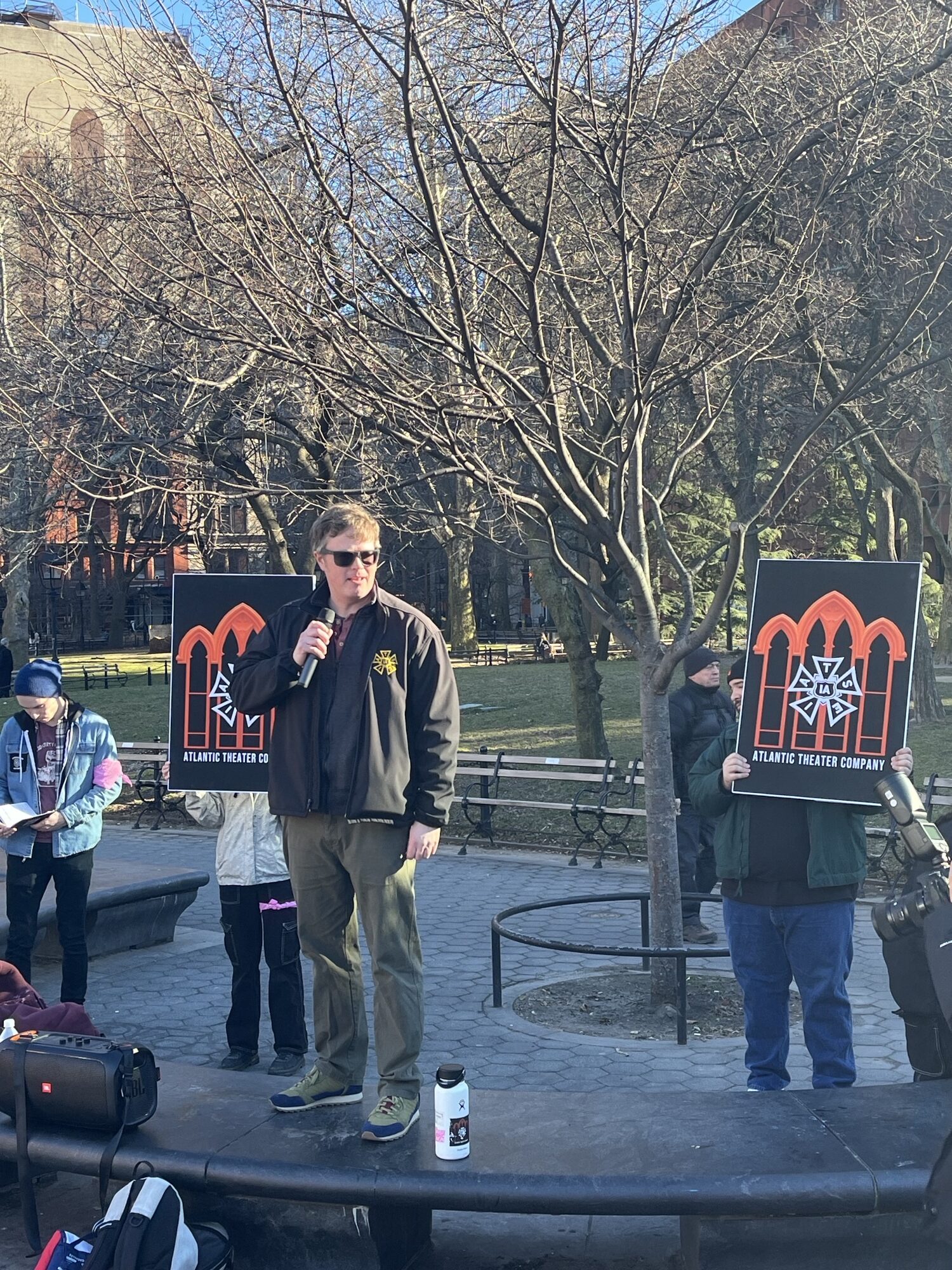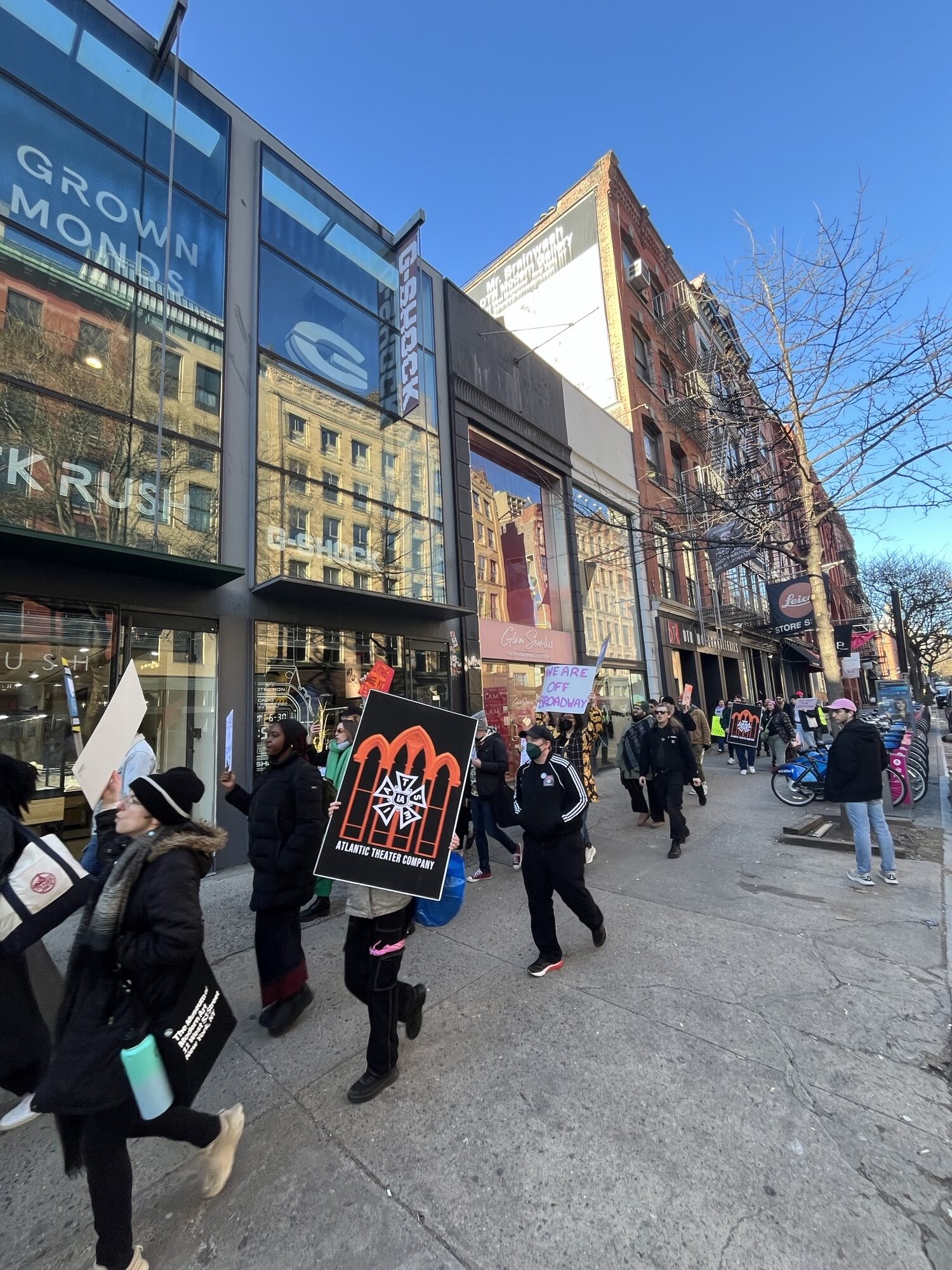
The International Alliance of Theatrical Stage Employees (IATSE) represents over 170,000 behind the scenes entertainment workers across North America. They work in all forms of live theater, motion picture and television production, trade shows and exhibitions, television broadcasting, and concerts, as well as the equipment and construction shops that support all these areas of the entertainment industry. The IATSE’s mission is to improve all entertainment workers’ lives both inside and outside the workplace.
To learn more about the IATSE’s work and how Action Builder fits in, I spoke with Dan Little, an International Representative for the IATSE, about the union’s work organizing entertainment workers in off-Broadway theatres in New York City — with the help of Action Builder.
Learn more about Action Builder here, sign up for a live demo here, or email us at join@actionbuilder.org to get started using the tool!
Welcome Dan, and thanks for talking with me today. Can you tell me more about the IATSE’s work using Action Builder?
Sure, absolutely. The IATSE has represented workers in theater since 1893. The first workers who we represented 130 years ago were folks who worked on Broadway. For the most part, the producers, the employers here who make shows on Broadway, they’re all party to the so-called Broadway League. They bargain with the union as a trade association for all of the work that happens on Broadway.

Pretty much soup-to-nuts, top-to-bottom, to a person, everyone who works on Broadway is in some union. Most of them are in IATSE, but there is also the Actors’ Equity Association, which represents actors, the Stage Directors and Choreographers Society, which represents directors and choreographers, and the American Federation of Musicians, which represents the musicians.
Now, conversely, in New York City, there is what has come to be referred to as ‘off-Broadway’. Off-Broadway theatres are most theatres in New York that are less than 500 seats. Everything 499 seats and less is classified ‘off-Broadway’. There is a trade association, the Off-Broadway League, who has some collective bargaining arrangements with Actors’ Equity and with some local unions of the IATSE, but for the most part, most production workers in these off-Broadway theatres have been unrepresented for forever.
“Action Builder and Action Network have been tremendously important in the organizing success that the IATSE has had.”
And some of that is just because, frankly, it’s a very difficult group of folks to organize. With shows that operate here, the producer will create a temporary company, and that company will exist for eight weeks, for twelve weeks, or however long the show is going to build itself and run. And in many cases, they’re for short periods of time. These are not indefinite open-ended shows. They’re going to run for a month, they’re running for six weeks, they’re running for 20 weeks, but then they’re going to close. And many of these producers are double-breasting, in so much as the same producer who’s producing on Broadway is producing off-Broadway. They have collective bargain agreements over here, on Broadway, and not over here, off-Broadway, which serves industrially in the community as the breeding ground, the place that producers will kick the tires on shows.

They’ll put out a beta version of the show off-Broadway, get audience feedback, and then take it back to the workshop. They might add characters, they might reduce characters, but they’ll do the revision so that the show can then proceed to Broadway, where they might hope it would have an extended run. Broadway is largely built on that model of workshopping: develop a show off-Broadway and then move it to Broadway because the house sizes are larger, the rents are higher, and the stakes are higher.
They might also use off-Broadway to build a buzz and excitement around a show, get some press going, and then transfer it over. A good example of this, there’s a Sufjan Stevens musical dance piece called Illinoise based on the album of the same name. They first did it off-Broadway for six weeks or so, and then transferred it to a Broadway theatre.
Hamilton is another example of a show that started off-Broadway and eventually transferred. I could really run down a list of all the big names of shows that you would know that all started off-Broadway. This has been the trend for years.
“Action Builder has allowed us to get a very real measure of who the workforce is and where they are working and how they are moving back and forth.”
And as I mentioned, much of off-Broadway has been unrepresented for many years. It’s been difficult to organize simply because most people who do this work will work for 10, 15, 20, 30 different employers over the course of their year. That’s very common.
This is a great organizing challenge for us because unlike a more traditional job, people are all over the place, and the labor market’s always churning. So where Action Builder has proven to be a huge benefit for us is that it’s allowed us to get a very real measure of who the workforce is and where they are working and how they are moving back and forth.
We approach this organizing from an industrial perspective. We’re working to organize all folks who work in the entertainment industry, and the IATSE represents all folks who work in the entertainment industry across many different craft lines. We have electricians, and we have carpenters. We have audio technicians and video engineers and wardrobe attendants and hair stylists and makeup artists, et cetera.

So Action Builder has been a godsend in terms of tracking. Back in July of ‘23, we called on a bunch of workers to organize, and they all came to a local union hall in New York City, and we had a town hall meeting to talk about this. One of the things we said there was, “If any of you workers are ready to organize, we’re here for you.” Since that time, we’ve organized five different shows including Titanic and Little Shop of Horrors.
Learn more about Action Builder here, sign up for a live demo here, or email us at join@actionbuilder.org to get started using the tool!
In Action Builder, we’re using the Connections feature pretty aggressively. We’ll have a campaign with an entity type for a person and an entity type for an employer. We’ll also use entity types for locations and entity types for unions. So in a single Action Builder instance, we might see that a person is a member of a local union and is working at this company that we just organized and is also working at this other company that we’d like to organize. Because we see that they’re a member of this local union and they work at this other company we organized, we know that that person might be a reasonable person to approach and initiate that conversation.
“Action Builder has been a godsend in terms of tracking.”
It sounds like the conditions have been there for a really long time to do this work to unionize these folks, and there’s been a technological barrier to getting that done. Is that your read on it? It sounds like you’re really winning these elections pretty handily.
We are. I want to acknowledge that some of that is generational. Some of that is the society at large and the world that we’re living in today and increased awareness of labor unions. But to your point, yes, there has been a huge information barrier to know where people are and what they’re doing, how they’re connected to each other. It’s an industry that we like to think it’s ‘50 people in mirrors’, meaning it’s not actually a lot of people who do this work. And so knowing where to pull and where to push and who has that sort of community power and being able to strategically put our finger on the scale in the right way at the right time with the right people has made all of the difference in our ability to do this.
So a lot of people in this industry turn 26, end up off their parents’ health insurance, and they have to go find something else to do with their lives. You mentioned 50 people in mirrors — it’s an interesting metaphor if the same 50 people are staying, but it sounds like it’s not just 50 people in mirrors, it’s constantly revolving, with new people graduating college and coming into the city and working. Half of the workforce is replaced regularly.
I think that’s true. We do see consistency with folks who are able to get connected with the union. Most of the tours that travel around are unionized jobs, and so many of these folks, they’ll get on a tour and they’ll become a member of the union through that process and through that job. And then they’ll come off of the tour, they’ll come back home, and now they’ll have a union card in their pocket, and they’ll end up doing some other job.

That’s part of our tracking with Action Builder as well, to be able to know who is where and how they’re moving around. Just last week we organized the Public Theater, an overwhelming victory and real mandate from the workers. It was 178 to 11, and there are approximately 270 or so eligible voters in that unit. And a notable thing is that those folks don’t even necessarily know each other. They end up working in such siloed corners of their world. Using Action Builder and putting that information in the hands of the workers committee so that they can know who each other are and foster better meaningful relationships with each other has been tremendously useful.
Is there anything I should have asked about that I didn’t?
Action Builder has been hugely beneficial in the organizing programs that the IATSE is conducting. We use Action Builder in connection with Action Network regularly, and we find that using a form in Action Network to collect data or event attendance and then have that data translated back in Action Builder is not only a clean way of handling the data, but it helps others in the bargaining unit to see what’s going on. It allows more people to get involved directly because we can control permissions and access.

We’ve used assessments in our organizing work for years, but the way that Action Builder puts assessments at the forefront has helped worker committees who are perhaps new to organizing come to those realizations quicker and more effectively.
Action Builder and Action Network have been tremendously important in the organizing success that the IATSE has had. We are really appreciative of the folks at Action Squared and the development team from the AFL-CIO, and we appreciate being regularly invited into the space to share our comments and opinions. It has helped the tool grow from when we first started messing around with it back in 2019 to today, and we’ve just been very pleased with it. We appreciate it.
We appreciate you. Thank you so much for taking the time to walk me through this case study.
You can learn more about the IATSE’s work organizing off-Broadway theatres at offbroadway.iatse.net.
You can learn more about Action Builder here, sign up for a live demo here, or email us at join@actionbuilder.org to get started using the tool.